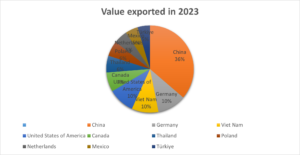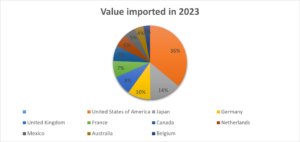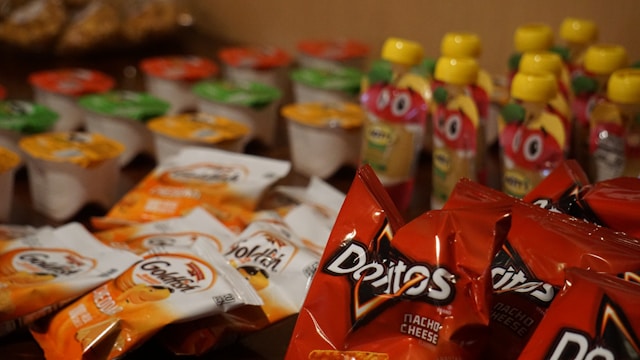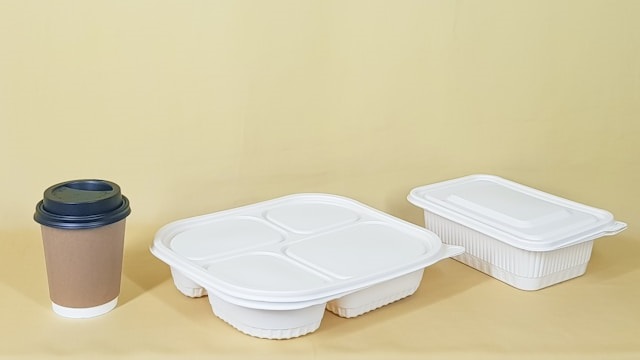Introduction
Flexible packaging materials under HS Code 392329 are pivotal in the global packaging industry. These materials include plastic films, bags, and pouches designed for a variety of uses across sectors such as food, pharmaceuticals, and industrial goods. In this analysis, we examine the global import and export landscape, focusing on the leading trading nations and regional insights, particularly in the Middle East and Eurasia.
Understanding HS Code 392321
HS Code 392321 covers flexible plastic packaging materials such as sacks, bags, and other containers of polymers of ethylene. These products are widely used due to their cost-effectiveness, durability, and versatility. Key industries utilizing these materials include food and beverage, pharmaceuticals, and consumer goods.
Global Export Data and Leading Exporters
The total global exports of flexible packaging materials in 2023 amounted to $13,195,924,000. The top 10 exporters and their respective export volumes are:
| Rank | Country | Export Value ($) |
|---|---|---|
| 1 | China | 3,324,351,000 |
| 2 | Germany | 968,786,000 |
| 3 | Vietnam | 905,400,000 |
| 4 | United States of America | 891,251,000 |
| 5 | Canada | 660,102,000 |
| 6 | Thailand | 569,008,000 |
| 7 | Poland | 522,219,000 |
| 8 | Netherlands | 465,653,000 |
| 9 | Mexico | 426,140,000 |
| 10 | Turkey | 422,140,000 |
Key Insights
- China dominates the export market, accounting for over 25% of global exports.
- European countries such as Germany, Poland, and the Netherlands are significant players, reflecting a robust manufacturing sector.
Global Import Data and Leading Importers
In 2023, global imports of flexible packaging materials totaled $12,394,519,000. The top 10 importers and their average tariffs are:
| Rank | Country | Import Value ($) | Avg. Tariff (%) |
|---|---|---|---|
| 1 | United States of America | 2,882,117,000 | 1.8 |
| 2 | Japan | 1,108,380,000 | 1.1 |
| 3 | Germany | 810,042,000 | 2.2 |
| 4 | United Kingdom | 682,428,000 | 1.7 |
| 5 | France | 576,523,000 | 2.2 |
| 6 | Canada | 537,397,000 | 1.6 |
| 7 | Netherlands | 456,714,000 | 0.0 |
| 8 | Mexico | 406,899,000 | 3.2 |
| 9 | Australia | 315,131,000 | 2.2 |
| 10 | Belgium | 231,678,000 | 2.2 |
Key Insights
- The United States is the largest importer, driven by its vast consumer market.
- Countries like the Netherlands benefit from duty-free imports, aiding their role as trade hubs.
Regional Import Analysis: Middle East and Eurasia
Uzbekistan
- Total Imports: $2,707,000
- Top Suppliers: China ($1,479,000), Turkey ($882,000)
- Average Tariff: 30%
United Arab Emirates
- Total Imports: $28,667,000
- Top Suppliers: China ($18,386,000), Thailand ($2,391,000)
- Average Tariff: 5%
Turkey
- Total Imports: $41,334,000
- Top Suppliers: Germany ($12,115,000), China ($7,069,000)
- Average Tariff: 6.5% for specific suppliers
Russia
- Total Imports: $111,240,000
- Top Suppliers: China ($66,354,000), Kazakhstan ($11,094,000)
- Average Tariff: 4.9%
Iraq
- Total Imports: $9,430,000
- Top Suppliers: Turkey ($7,150,000), China ($2,203,000)
- Average Tariff: Not applicable
Tariff Analysis
Tariff structures vary widely among countries, influencing trade dynamics:
- Uzbekistan imposes a high tariff of 30%, likely protecting local industries.
- UAE maintains a low tariff of 5%, fostering trade and imports.
- Turkey applies selective tariffs, balancing local and international trade interests.
Data Visualization
Global Export and Import Volumes


- Pie Chart: Showing the percentage share of each country in global exports and imports.
Conclusion and Insights
The flexible packaging industry under HS Code 392329 demonstrates significant global trade activity. Key findings include:
- China’s dominance as both a leading exporter and supplier to many regions.
- United States and European nations remain critical markets due to high consumption.
- Regional variations in tariffs significantly impact trade flows, with countries like Uzbekistan imposing higher barriers compared to the UAE’s more open policies.
For businesses, understanding these dynamics is crucial for optimizing supply chains and market strategies. The Middle East and Eurasian markets, despite tariff challenges, present growth opportunities due to rising demand and strategic geographic positions.
Data Source
The data presented in this report is sourced from Trade Map (2023), providing comprehensive trade statistics for flexible packaging materials under HS Code 392321.










